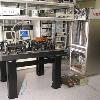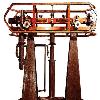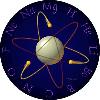

Atomuhr FOCS-1 (Schweiz) Tags: Atomic Clock View |
Tags: Atomic Clock View |
a b 3 4 5 6 Constantly Ticking 1 Tags: Atomic Clock View |
|||||||||
atomic clock is a type of clock that uses an atomic resonance frequency standard as its timekeeping element. They are the most accurate time (time standard) and frequency standards known, and are used as primary standards for international time distribution services (Time dissemination), to control the frequency of television broadcasts, and in global navigation satellite systems such as GPS.
Atomic clocks do not use radioactivity, but rather the precise microwave signal that electrons in atoms emit when they change energy levels. Early atomic clocks were based on masers. Currently, the most accurate atomic clocks are based on absorption spectroscopy of cold atoms in atomic fountains such as the NIST-F1.
National standards agencies maintain an accuracy of 10?9 seconds per day (approximately 1 part in 1014), and a precision set by the radio transmitter pumping the maser (laser pumping). The clocks maintain a continuous and stable time scale, International Atomic Time (TAI). For civil time, another time scale is disseminated, Coordinated Universal Time (UTC). UTC is derived from TAI, but synchronized, by using leap seconds, to UT1 (Universal Time), which is based on actual rotations of the earth with respect to the solar time.
Classification: Clock
Industry: Telecommunications, Science
Application: GPS
Powered: Yes
Invented: 1949
Inventor: US National Bureau of Standards
Examples: Image:Usno-mc.jpgthumbrightThe master atomic clock ensemble at the U.S. Naval Observatory (United States Naval Observatory) in Washington D.C., which provides the time standard for the USA. The rack mounted units in the background are HP 5071A cesium beam clocks. The black units in the foreground are Sigma-Tau MHM-2010 hydrogen maser standards. An



